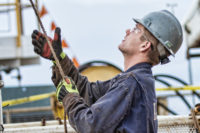What to look for
|
There are many things an EHS manager can look for to help him or her make hand safety decisions:
1) Make sure the impact protection extends all the way to the finger tips. This reduces pinching fractures and bruises to the finger tips.
2) Make sure the impact-protective thermoplastic rubber (TPR) pads are long, with wide cross-sections. Small TPRs and narrow cross-sections don’t maintain lateral stability during impact.
3) TPR coverage specifically needs to protect and cover all bones, joints and fingers. For example, having only three TPRs on the back of the hand to cover four metacarpal bones will not be sufficient protection.
4) Make sure that flex-points are built into the TPR design. The TPR still needs to protect and absorb impact, but integrated flex-points allow the hand to fully open and close without “puffing” away from the hand or exposing bones. This also allows for increased comfort and dexterity which allows the worker to maintain a high level of work-efficiency.
ASTM testing
Although there are no industry-wide testing standards for impact force reduction, true hand impact testing does exist. Note that ASTM does not have a test for reduction in hand impact force, and the ASTM rebound test should not be used as a substitute. The rebound test does not measure impact forces to the hand from heavy objects; it only measures the rebound height of a small steel ball on a flat surface. Rebound height has no correlation to the impact force delivered to the “object” beneath the protective piece, and the test is not performed on a hand. This data can be misleading and can leave the worker vulnerable to real-world impact hazards.
Peak impact force reduction
True hand impact testing provided by glove manufacturers must evaluate the reduction of peak impact force, as this is the leading cause of fractures and severe bruising to the bones in the human hand. Measurement of peak impact force reduction can be made with the gloves being worn on a Ballistic Mannequin Hand, while the force measurements should be taken on the surface of the hand beneath the protective glove. The Ballistic Mannequin Hand must mimic the soft tissue and hard structure (bones) of the human hand, as well as the three dimensional shape of the hand. A wooden or plastic hand, or a flat surface test, will not give accurate readings of real-world hazards. The impact measurements can then be taken from three different regions: the metacarpal region, the fingers, and the knuckles, and must be presented as a percentage of reduction in peak impact force at each region of the hand.
No glove is invincible
EHS managers can utilize this information to make better decisions. For example, an 80-percent reduction in peak impact force equates to a 200-lb. impact (which will cause serious injury) being reduced to a 40-lb. impact (likely to cause bruising only). Caution should be taken however, as thresholds for injuries vary widely from person to person and between different types of injuries (pinching, bruising and fractures).
Finally, glove impact protection should be viewed as a last line of defense. The first line is always safety training and behavior modification. The second line is workplace hazard reduction. No glove is invincible and must be viewed as a complimentary piece of the safety training puzzle. There are excellent gloves in the marketplace that can help reduce recordable injuries, and knowing what to look for can make all the difference in the world.


